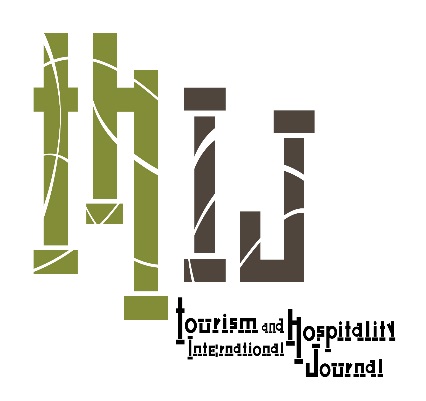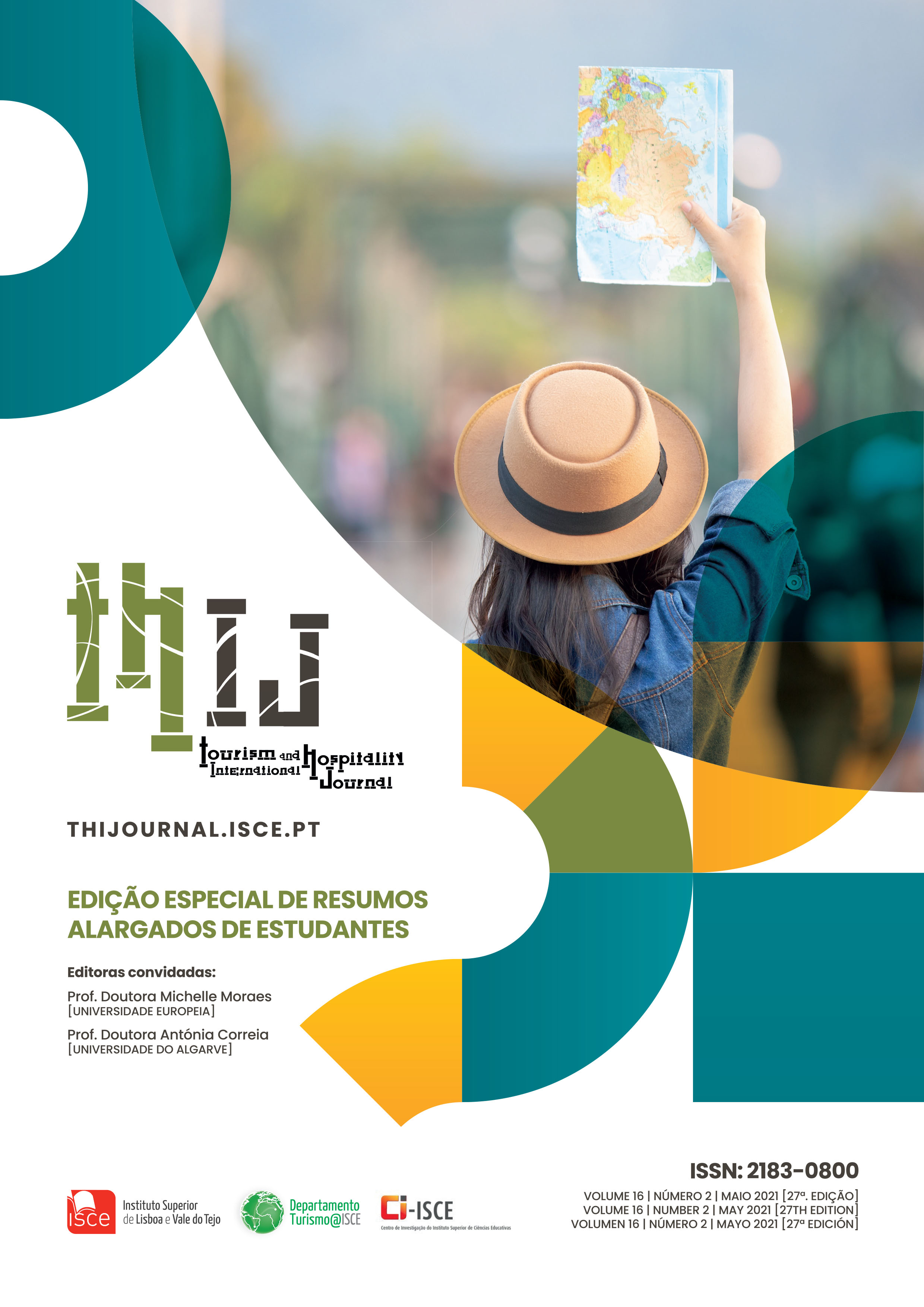Planeamento do turismo em Sundarbans através de um sistema de informação geográfica
DOI:
https://doi.org/10.57883/thij16(2)2021.30904Palabras clave:
Sundarbans, Producto turístico, Planificación turística, Sistema de información geográfica, GeoportaResumen
Sundarbans es el destino turístico natural más extravagante situado en el este de la India. El hermoso bosque de manglares ofrece una vibrante flora y fauna a los visitantes. Un gran número de turistas visitan Sundarbans cada año no sólo por su flora y fauna, sino también por la excelente mezcla de recursos culturales e históricos. Sin embargo, la industria turística no se ha desarrollado correctamente debido a la falta de una clasificación adecuada de los productos turísticos y de una planificación científica. El Sistema de Información Geográfica puede ser una de las herramientas más útiles para el desarrollo turístico de Sundarbans. Este capítulo presenta el proceso de desarrollo de circuitos turísticos en Sundarbans. El capítulo también destaca el alcance y la posibilidad de una planificación turística científica mediante el uso del Sistema de Información Geográfica. Se prepara un mapa interactivo de Sunderbans utilizando el software ArcGIS 10.0 para mostrar la arquitectura conceptual de la gestión de la información turística mediante el uso de un portal interactivo basado en SIG.
Citas
Avdimiotis, S., & Christou, E. (2004). GIS applications in tourism planning: A tool for sustainable development involving local communities. Journal of Environmental Protection & Ecology, 5(2), 457- 468. Retrieved February 05, 2021, from http://195.251.240.227/jspui/handle/123456789/4609
Bahaire, T., & Elliott-White, M. (1999). The application of geographical information systems (GIS) in sustainable tourism planning: A review. Journal of Sustainable Tourism, 7(2), 159-174. doi:10.1080/09669589908667333
Banerjee, A. (1998). Environment, population, and human settlements of Sundarban Delta. Concept Publishing Company. Retrieved from https://books.google.co.in/books?hl=en&lr=&id=zf_xv9LRd4cC&oi=fnd&pg=PA7&dq=Banerjee,+A.,+1998.+Environment,+population,+and+humansettlements+of+Sundarban+Delta.+Concept+Publishing+Company.&ots=GGFJdangA2&sig=3UDLUUMtYOKcfkW_UoUovJ47lNQ&redir_esc=y#v=onep
Biswas, S., Rakshit, D., Sarkar, S. K., Sarangi, R. K., & Satpathy, K. (2014). Impact of multispecies diatom bloom on plankton community structure in Sundarban mangrove wetland, India. Marine pollution bulletin, 85(1), 306 -311. doi:10.1016/j.marpolbul.2014.04.015
Boers, B., & Cottrell, S. (2007). Sustainable tourism infrastructure planning: A GIS-supported approach. Tourism Geographies, 9(1), 1 -21. doi:10.1080/14616680601092824
Bonham, C., & Graeme, F. (2014). Geographic information systems for geoscientists: modelling with GIS (Vol. 13). USA: Elsevier. Retrieved February 2, 2021, from https://books.google.co.in/books?hl=en&lr=&id=FkKeBQAAQBAJ&oi=fnd&pg=PP1&dq=Bonham-Carter,+GF,+2014.+Geographic+informationsystems+for+geoscientists:+modelling+with+GIS+(Vol.+13).+Elsevier&ots=NexIo51-Fu&sig=vfqntfJGmsQFdN7uZpaogwbUY-M&redir_esc=y#v=onepa
Chandel, R. S., & Kanga, S. (2018). Use of Geo-Spatial Techniques to Manage the Tourists & Administration: A Case Study of Mount Abu, Rajasthan. Society for Environment and Development,(India. Retrieved January 27, 2021, from http://www.sedindia.org
Delorme, D., Gray, K., Autry, G., & Moulton, K. (2001, November 20). Integrated routing/mapping information. US Patent 6,321,158. Google Patents. Retrieved February 1, 2021, from https://patents.google.com/patent/US6321158B1/en
Fung, T., & Wong, F. K. (2007). Ecotourism planning using multiple criteria evaluation with GIS. Geocarto International, 22(2), 87-105. doi:10.1080/10106040701207332
Garc, a.-P., Juan, C., Gutierrez, J., & Mnguez, C. (2015). Identification of tourist hot spots based on social networks: A comparative analysis of European metropolises using photo-sharing services and GIS. Applied Geography, 63, 408--417. doi:0143622815001952
Goodbred, J., Steven, L., Paolo, P., Ullah, M., Pate, R., Khan, S., . . . Rahaman, W. (2014). Piecing togetherthe Ganges-Brahmaputra-Meghna River delta: Use of sediment provenance toreconstruct the history and interaction of multiple fluvial systems duringHolocene delta evolution. Geological Society of America Bulletin, 126(11-12), pp. 1495--1510. doi:10.1130/B30965.1
Hallo, J., Beeco, J., Goetcheus, C., McGee, J., McGehee, N., & Norman, W. (2012). GPS as a method for assessing spatial and temporal use distributions of nature-based tourists. Journal of Travel Research, 51(5), 591-606. doi:10.1177/0047287511431325
Ishtiaque, A., S.W, M., & Wang, C. (2016). Examining theecosystem health and sustainability of the world's largest mangrove forestusing multi-temporal MODIS products. Science ofthe Total Environment, 569, 1241--1254. doi:https://doi.org/10.1016/j.scitotenv.2016.06.200
Lange, E., & Bishop, I. (2005). Visualization in landscape and environmental planning: technology and applications. Taylor & Francis. Retrieved January 27, 2021, from https://books.google.co.in/books?hl=en&lr=&id=4_PYxp31zGwC&oi=fnd&pg=PR9&dq=Lange,+E.+and+Bishop,+I.D.,+eds.,+2005.+Visualisationin+landscape+and+environmental+planning:+technology+and+applications.+Taylor%26+Francis.&ots=lXJ_dcak_s&sig=FO5ZSHW3gD0Q7zlm_1
Li, X., & Yeh, A.-O. (2004). Analyzing spatial restructuring of land use patterns in a fast growing region using remote sensing and GIS. Landscape and Urban planning, 69(04), 335-354. doi:0169204603002500
Liu, D., Iverson, L., & Brown, S. (1993). Rates and patterns of deforestation in the Philippines: application of geographic information system analysis. Forest Ecology and Management, 57(1-4), 1-16. doi:10.1016/0378-1127(93)90158-J
Manna, S., Chaudhuri, K., Bhattacharyya, S., & Bhattacharyya, M. (2010). Dynamics of Sundarban estuarine ecosystem: eutrophication induced threat to mangroves. Saline systems, 6(1), 1-16. doi:10.1186/1746-1448-6-8
Montgomery, S. (2009). Spell of the tiger: the man-eaters of Sundarbans. Chelsea Green Publishing. Retrieved January 31, 2021, from https://books.google.co.in/books?hl=en&lr=&id=zU7PmIjthpoC&oi=fnd&pg=PR9&dq=Montgomery,+S.,+2009.+Spell+of+the+tiger:+theman-eaters+of+Sundarbans.+Chelsea+Green+Publishing&ots=K7JBktlUKX&sig=UYyRKqbX-oBbaZKJV_aXdo0ZWmk&redir_esc=y#v=onepage&q=Montgomery%2
Naha, D., Jhala, Y., Qureshi, Q., Roy, M., Sankar, K., & Gopal, R. (2016). Ranging, activity and habitat use by tigers in the mangrove forests of the Sundarban. PLoS One, 11(4), e0152119. doi:10.1371/journal.pone.0152119
Raha Atanu Kumar, et al. (2015). Impact of Sea Level Rise on Mangrove Vegetation of Sundarban Tiger Reserve. Journal of Ecology and Environmental Sciences, 6(2), 154 - 162. doi:10.9735/0976-9900
Sahana, M., & Sajjad, H. (2019). Vulnerability to storm surge flood using remote sensing and GIS techniques: A study on Sundarban Biosphere Reserve, India. Remote Sensing Applications: Society and Environment, 13, 106-120. doi:10.1016/j.rsase.2018.10.008
Sen, N. S. (2003). axonomy and ecology of the algal flora of Sundarbans Mangals in West Bengal India with special reference to estimation of their contribution to the primary productivity of the estuarine ecosystems. Kolkata: Sodhganga. Retrieved January 23, 2021, from https://shodhganga.inflibnet.ac.in/handle/10603/155976
Descargas
Publicado
Cómo citar
Número
Sección
Licencia
Derechos de autor 2023 This work is licensed under a Creative Commons - Attribution 4.0 International (CC BY 4.0)

Esta obra está bajo una licencia internacional Creative Commons Atribución 4.0.
Este trabalho encontra-se publicado com a Licença Internacional Creative Commons Atribuição 4.0.






